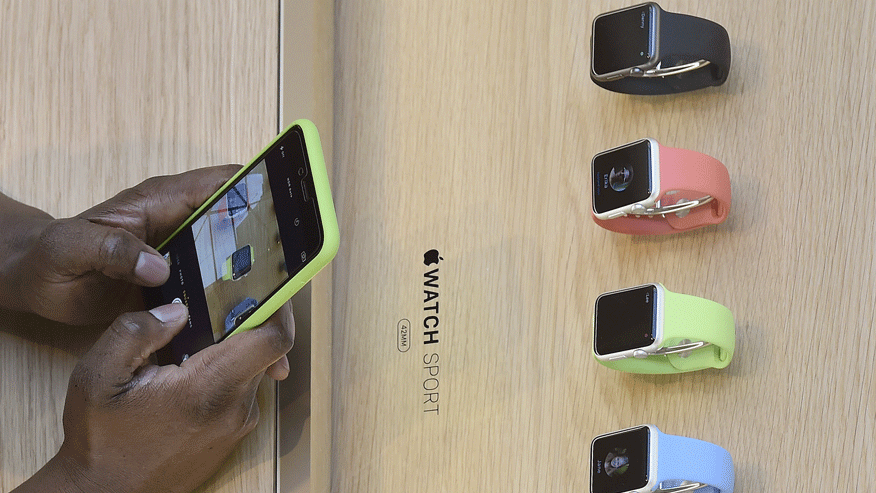
A customer views samples of Apple Watches at the Apple Store in Covent Garden in London, April 10, 2015 (REUTERS/Toby Melville)
It was an old “Saturday Night Live” joke: “It's a floor wax and a dessert topping!”
Now, technology is turning the gag into reality.
It's not sufficient, for example, to just be a light bulb or just camera any more. It also has to be remotely controlled from thousands of miles away and play music, watch the kids, and keep track of your appointments. It may even help you learn French.
The question is do we really want everything to turn into a digital Swiss Army knife of multiple functions and features?
The question was brought into comical relief recently when I was testing a pair of LED light bulbs that that also function as Bluetooth stereo speakers. The Sengled Pulse LED + Wireless Speaker JBL by Harman comes in a package with two bulbs, to create stereo sound, of course. They fit in standard home light bulb sockets, replacing conventional 6O-watt incandescent bulbs. The Pulse bulbs are on the warm or yellowish end of the spectrum, consume about 15 watts of power (so you'll save electricity), and can be remotely switched on and dimmed using a smartphone app (Apple or Android).
At $170 for a pair of bulbs, the Pulse LED's seem expensive until you consider that Bluetooth speakers that cost over $200 don't sound as good — and those speakers don't do double duty as sources of illumination. In fact, the Pulse bulbs — depending on their location — do an excellent job replacing the type of in-wall speakers that used to require a professional installation. Just screw the bulbs into the ceiling fixtures in a bathroom or bedroom, connect to any Bluetooth music source, and you've got music without the hassle of wires or boxes cluttering up the place.
I tested the Sengled Pulse speakers with several smartphones, streaming music services, and even Sony's Hi-Res Audio NWZ-A17 Walkman. The sound was remarkably crisp and undistorted considering the compact area in which these speakers have to operate. Each bulb has a 1.75-inch driver with a rated frequency response of 100 Hz to 20 kHz. Consequently, they don't deliver the kind of bass response of a large bookshelf speaker but they do well with everything from Marianne Faithful to Miles Davis. This is perfect for a kitchen, bathroom, or bedroom music system.
Quite a useful combination of functions in a single device, I thought, until one day I was trying to learn the proper pronunciation of "caryatids." When I pushed the speaker icon on my phone, nothing came out. So I kept pushing the button (isn't that what everyone does?). Suddenly, my daughter was complaining about strange poltergeist-like voices emanating from the bedroom. I kept pushing the button. More complaining.
Then I realized I was blasting a British woman's voice shouting "caryatid" over and over again in the bedroom. Did I admit this technological faux pas to my daughter? Absolutely not.
So things with the Internet of things are not so seamless after all. But the devices keep coming, such as cameras that not only monitor your home for intruders, but also sniff out pollutants. The Withings Home, for example, is a $200 Web cam with a motion sensor and a detector that alerts you to spikes in volatile organic compounds (often the kind of pernicious fumes that come from vinyl products).
According to Alex Ruan of Sengled, the multiplicity of features sprouting from such devices is going to get worse, or better, depending on your point of view. Ruan said he expects LED bulbs, the company's mainstay, to soon have video cameras built in with motion sensors and various networking radios to improve Wi-Fi and other communications around the home.
The trend should not be so surprising as traditional items around us undergo such transformations.
Thermostats like Nest are also motion sensors, tracking occupants. Networked door locks can e-mail you when the kids come home. Cars can tell you where your teen went and if they exceeded the speed limit.
Of course, the smartphone is the sine qua non of a multifaceted digital utility belt. It's a phone, a computer, a biometric reader, a music player, a heart rate monitor, a navigation device, a camera, a camcorder, a remote control, a portable TV, and a game console. It can start a car and open a front door lock. And it does each of these tasks with greater skill with each new iteration (well, except for that part about making a phone call).
But is there a limit to how much of this mash up of technologies we can endure? Will clothes that monitor our adrenal glands, UV exposure, and warn us about high blood sugar finally drive us nuts?
Some of these digital chimeras are not appealing to people. Living room TVs have not caught on as video chat devices, for example. But the biggest test is coming this week as hundreds of thousands of Apple Watches arrive in anxious owners’ hands, ready to tap and swipe apps on their wrists. Will they become the iPods of this generation or eventually replace smartphones altogether when more features are added? I'll let you know when I figure out to shut off the speakers, er, lights.
